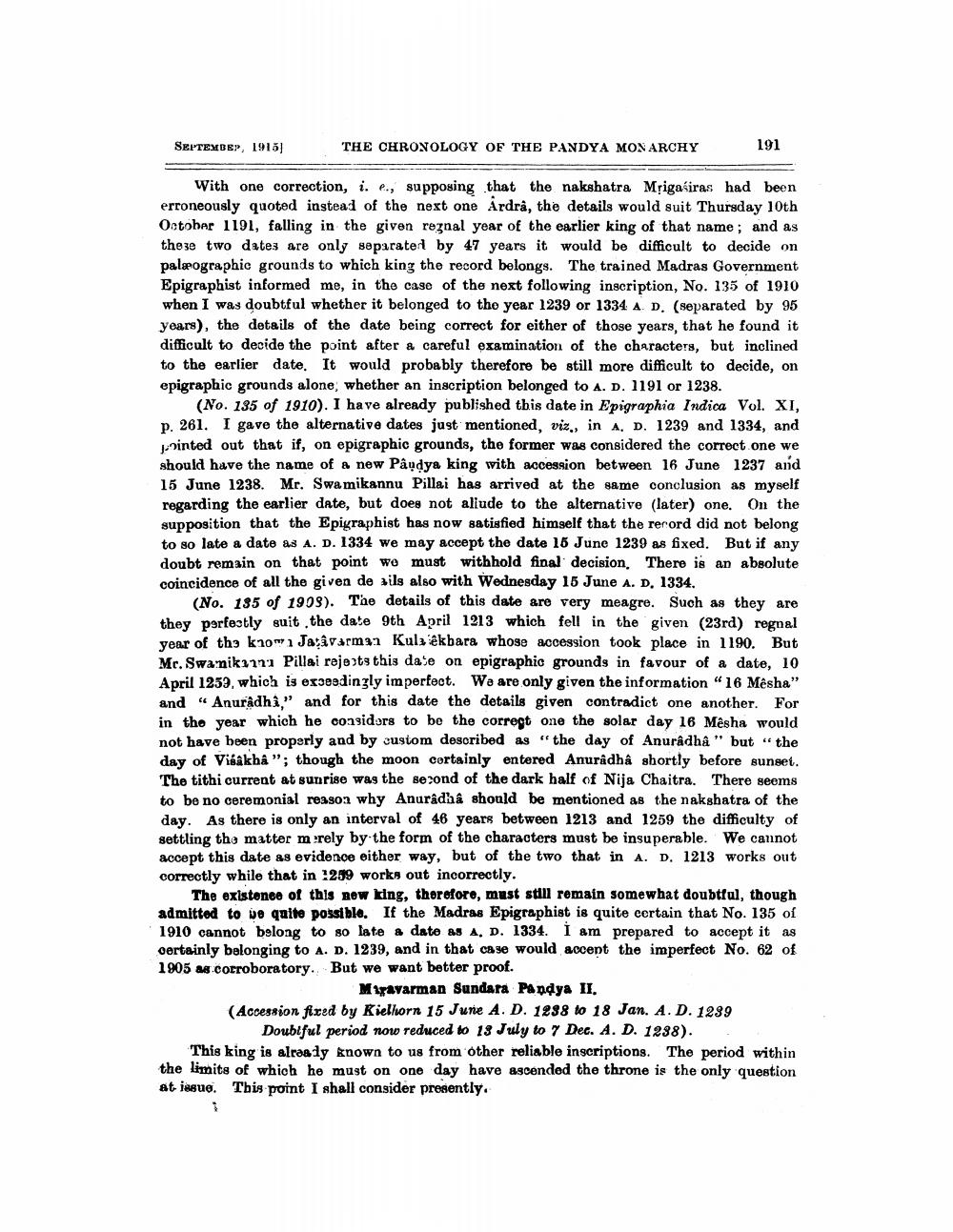________________
SEPTEMBEP, 1915)
THE CHRONOLOGY OF THE PANDYA MONARCHY
191
With one correction, i. e., supposing that the nakshatra Mrigasiras had been erroneously quoted instead of the next one Årdra, the details would suit Thursday 10th October 1191, falling in the given regnal year of the earlier king of that name, and as these two dates are only separated by 47 years it would be difficult to decide on palæographic grounds to which king the record belongs. The trained Madras Government Epigraphist informed me, in the case of the next following inscription, No. 135 of 1910 when I was doubtful whether it belonged to the year 1239 or 1334 A D. (separated by 95 years), the details of the date being correct for either of those years, that he found it difficult to decide the point after a careful examination of the characters, but inclined to the earlier date. It would probably therefore be still more difficult to decide, on epigraphic grounds alone, whether an inscription belonged to A.D. 1191 or 1238.
(No. 135 of 1910). I have already published this date in Epigraphia Indica Vol. XI, p. 261. I gave the alternative dates just mentioned, viz., in A. D. 1239 and 1334, and
pinted out that if, on epigraphic grounds, the former was considered the correct one we should have the name of a new Pâydya king with accession between 16 June 1237 and 15 June 1238. Mr. Swamikannu Pillai has arrived at the same conclusion as myself regarding the earlier date, but does not aliude to the alternative (later) one. On the supposition that the Epigraphist has now satisfied himself that the rerord did not belong to so late a date as A. D. 1334 we may accept the date 16 June 1239 as fixed. But if any doubt remain on that point we must withhold final decision. There is an absolute coincidence of all the given de zils also with Wednesday 15 June A. D. 1334.
(No. 135 of 1903). The details of this date are very meagre. Such as they are they perfestly guit.the date 9th April 1213 which fell in the given (23rd) regnal year of tha kom Jarâvarma. Kulz fékbara whose accession took place in 1190. But Mr. Swamikanı Pillai rejests this date on epigraphic grounds in favour of a date, 10 April 1259, which is exseedingly imperfect. We are only given the information “16 Mesha" and « Anuradhi," and for this date the details given contradict one another. For in the year which he considors to be the correct one the solar day 16 Mêsha would not have been properly and by custom described as "the day of Anuradha " but "the day of Vibakba"; though the moon certainly entered Anuradha shortly before sunset. The tithi current at sunrise was the second of the dark half of Nija Chaitra. There seems to be no ceremonial reaso3 why Anuradha should be mentioned as the nakshatra of the day. As there is only an interval of 46 years between 1213 and 1259 the difficulty of settling the matter m rely by the form of the characters must be insuperable. We cannot accept this date as evidence either way, but of the two that in A. D. 1213 works out correctly while that in 259 works out incorrectly.
The existence of this bow king, therefore, must still remain somewhat doubtful, though admitted to be quite possible. If the Madras Epigraphist is quite certain that No. 135 of 1910 cannot belong to so late a date as A.D. 1334. I am prepared to accept it as oertainly belonging to A. D. 1239, and in that case would accept the imperfect No. 62 of 1905 as corroboratory. But we want better proof.
Miravarman Sandara Pandya II. (Accession fixed by Kielhorn 15 June A. D. 1288 to 18 Jan. A.D. 1239
Doublful period now reduced to 18 July to y Dec. A.D. 1238). This king is alraa ly known to us from other reliable inscriptions. The period within the limits of which he must on one day have ascended the throne is the only question at issue. This point I shall consider presently.




